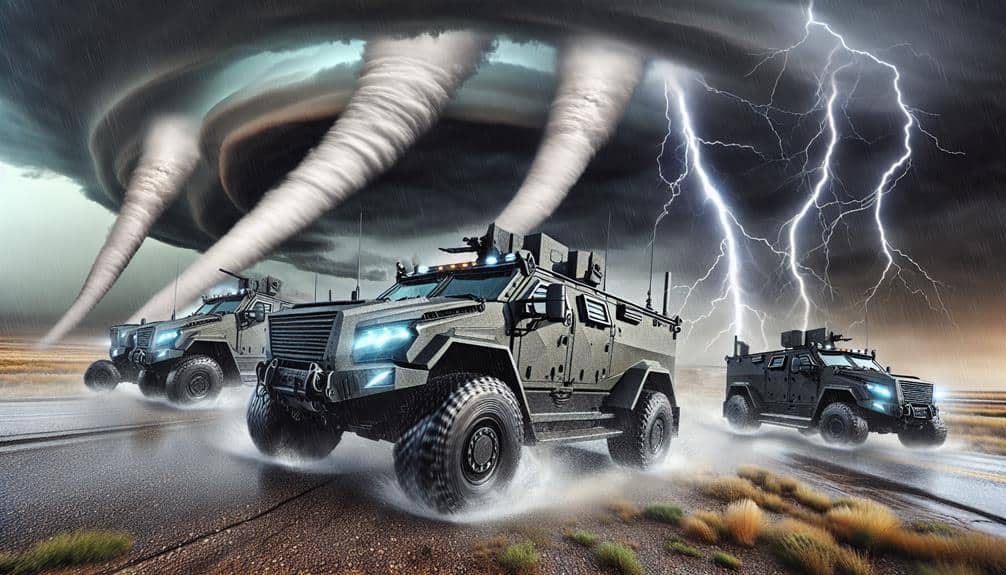In our ultimate handbook to wind speed measurement tools, we delve into various advanced technologies. Anemometers, necessary for tornado tracking, gather real-time data and convert mechanical motion into digital signals. Doppler radar systems offer unparalleled precision in measuring wind particle velocity and identifying storm cell rotations. Portable wind meters and UAV wind sensors provide real-time, high-resolution measurements, crucial for disaster response and optimizing wind farm locations. Weather balloons and probes offer essential atmospheric data through radiosondes. Each tool enhances our wind analysis capabilities, and by delving deeper, you'll uncover extensive insights into their applications and integrations.
Key Points
- Anemometers provide real-time data by converting wind speed into digital signals, crucial for storm analysis and tornado tracking.
- Doppler radar systems measure wind particle velocity and rotation, offering high accuracy in wind speed and direction monitoring.
- Portable wind meters offer handheld, real-time wind speed and direction measurements, with features like digital displays and Bluetooth connectivity.
- UAV wind sensors deliver high-resolution, multi-dimensional atmospheric data, essential for disaster response and optimizing wind farm locations.
Anemometers for Tornado Tracking
Utilizing anemometers for tornado tracking enables us to collect real-time wind speed data essential for precise storm analysis and prediction. By deploying these accurate instruments, tornado chasers like us can capture wind speeds at varying altitudes and positions relative to the storm. This data is vital for evaluating the intensity and potential path of tornadoes, thereby enhancing our storm monitoring capabilities.
Anemometers measure wind speed using rotating cups or blades, converting mechanical motion into digital signals. We can deploy portable anemometers directly into the path of tornadoes or install them on mobile units to follow the storm's trajectory. This flexibility ensures we obtain thorough wind profiles, even in the most unpredictable conditions.
For tornado chasers, accurate wind speed data isn't only about science; it's about safety and freedom. Knowing wind speeds in real-time allows us to make informed decisions, reducing risks while enabling us to pursue the storm closely.
Additionally, integrating anemometer data with other monitoring systems enhances our analytical models, providing a strong foundation for predicting tornado behavior. Therefore, utilizing anemometers in storm monitoring not only fuels our quest for knowledge but also helps us do so with precision and safety.
Doppler Radar Systems
Doppler radar systems allow us to measure the velocity of wind particles within a storm by analyzing the frequency shift of returned signals, providing essential data for tracking and predicting tornado paths. These systems operate by emitting microwave signals that bounce off atmospheric particles. When these particles are in motion, the frequency of the returned signal shifts, enabling us to calculate their speed and direction with remarkable precision.
In storm forecasting, Doppler radar offers unparalleled wind direction accuracy, vital for predicting severe weather events. The ability to monitor wind speed in real-time provides meteorologists with actionable data, thereby enhancing our overall severe weather detection capabilities.
For instance, by identifying rotation within a storm cell, Doppler radar can alert us to potential tornado formation well in advance. This early warning system is invaluable for safeguarding lives and property.
Moreover, Doppler radar systems contribute significantly to wind speed monitoring, offering detailed insights into wind patterns at various altitudes. This data isn't just important for weather forecasting but also for aviation safety and maritime operations. By integrating Doppler radar data, we enhance our ability to make informed, timely decisions, thereby maximizing our operational freedom and safety.
Portable Wind Meters
Portable wind meters, often referred to as anemometers, offer a convenient and precise way to measure wind speed and direction in real-time. These devices are essential for those of us who need reliable data on the go. With advancements in technology, handheld wind gauges now provide accurate readings, allowing us to make well-informed decisions whether we're sailing, hiking, or conducting field research.
Modern portable wind meters come equipped with digital displays and built-in wind direction indicators, allowing us to capture detailed data effortlessly. Many models include features such as data logging and Bluetooth connectivity, enabling seamless data transfer to our smartphones or tablets. This integration allows us to analyze wind patterns over time, giving us a deeper understanding of our environment.
When selecting a handheld wind gauge, we should consider factors such as measurement range, accuracy, and durability. High-quality anemometers typically offer a wind speed range of 0.3 to 30 m/s with an precision of ±2%. Additionally, rugged construction ensures our device can withstand harsh outdoor conditions, providing long-lasting performance.
UAV Wind Sensors
UAV wind sensors have transformed the way we collect wind data by enabling high-resolution, real-time measurements in previously inaccessible areas. By deploying these sensors on unmanned aerial vehicles (UAVs), we can gather extensive wind data analysis, essential for various UAV applications. These sensors provide unparalleled accuracy, vital for meteorological research, agricultural monitoring, and environmental assessments.
Using UAVs equipped with advanced wind sensors, we can perform vertical and horizontal wind profiling with precision. This capability enhances our understanding of wind patterns at different altitudes, which is necessary for optimizing wind farm locations and improving weather forecasting models. UAV wind sensors can measure parameters such as wind speed, direction, temperature, and humidity, offering a multi-dimensional view of the atmospheric conditions.
In addition, UAV applications extend to disaster response, where real-time wind data is crucial for coordinating relief efforts and ensuring safety. These sensors also support scientific exploration in remote or hazardous locations, where traditional wind measurement tools fall short.
Weather Balloons and Probes

Weather balloons and probes frequently provide essential atmospheric data by ascending to various altitudes and transmitting real-time measurements of wind speed, temperature, pressure, and humidity back to ground stations. These tools are necessary for obtaining altitude readings with precision accuracy. By reaching altitudes where other instruments might fail, weather balloons and probes enable us to gather thorough meteorological data vital for understanding atmospheric conditions.
When a weather balloon is launched, it carries a radiosonde—a compact, battery-powered instrument—into the sky. As the balloon ascends, the radiosonde transmits detailed data on wind speed and direction, among other parameters, at various altitudes. This enables meteorologists to construct vertical profiles of atmospheric conditions, which are crucial for accurate weather forecasting and climate studies.
Probes, often attached to the balloons, enhance our data collection capabilities by measuring additional atmospheric variables. Their precision accuracy is particularly valuable for detecting subtle changes in wind speed and direction at different altitudes. This granular data helps us predict severe weather events and better understand atmospheric dynamics.
Data Logging Devices
Although often overlooked, data recording tools play an important role in capturing and storing wind velocity measurements for subsequent analysis. These tools enable us to perform remote monitoring, which is vital for collecting continuous data from hard-to-reach locations. By leveraging modern technology, we can verify that our wind speed measurements are both accurate and dependable.
Data recorders typically integrate with anemometers and other wind measurement instruments to record data over extended periods. The collected data is priceless for trend analysis, forecasting, and even for calibrating other instruments. Calibration techniques are essential to guarantee that the data recorders provide precise readings. Regular calibration against a known standard mitigates errors and enhances the reliability of the recorded data.
Furthermore, these tools often come equipped with wireless communication capabilities, allowing us to access real-time data remotely. This feature is particularly advantageous for those of us who value the freedom to monitor environmental conditions from anywhere.
Frequently Asked Questions
How Do Wind Speed Measurement Tools Ensure Accuracy in Diverse Weather Conditions?
We guarantee accuracy in diverse weather conditions by using precise calibration techniques and accounting for various environmental factors. By continuously adjusting for temperature, humidity, and pressure changes, we maintain reliable wind speed measurements, empowering informed decision-making.
What Maintenance Is Required for Long-Term Reliability of Wind Speed Measurement Tools?
Regular maintenance guarantees 95% accuracy: We perform calibration checks every six months and follow strict cleaning procedures to remove debris. This keeps our wind speed measurement tools reliable, even in diverse weather conditions, maintaining our data remains precise.
Are There DIY Options for Building Basic Wind Speed Measurement Devices?
Yes, we can explore DIY options for building basic devices. Employing proper calibration methods and accuracy techniques guarantees reliable measurements. This approach empowers us with freedom to create cost-effective, customized wind speed measurement solutions.
How Do Wind Speed Measurement Tools Integrate With Weather Forecasting Software?
Like Prometheus bringing fire, we integrate wind speed measurement tools with weather forecasting software by ensuring data integration and software compatibility. This enhances forecast accuracy, provided tool calibration is precise and up-to-date, ensuring our predictions are reliable.
What Are the Cost Differences Between Various Wind Speed Measurement Tools?
When analyzing the cost differences between wind speed measurement tools, we see a clear price comparison. Budget options offer basic functionality, while higher-priced models provide advanced features and quality assurance. Buyers should balance cost with desired performance.

